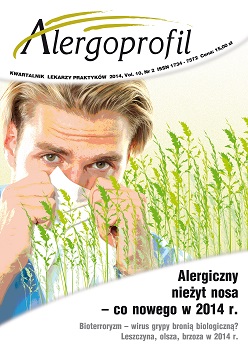Symptoms of rhinitis in an eight years old girl. Case discussion
Main Article Content
Abstract
Rhinitis represents global health problems for all age groups. The prevalence of rhinitis in Poland, especially allergic rhinitis, has dramatically increased in the past two decades. Rhinitis symptoms; congestion, rhinorrhea, sneezing and nasal pruritis can significantly affect the quality of life. Allergic rhinitis diagnosis is based on medical history, positive skin pick tests with allergens and/or high level of serum specific anty-IgE antibodies. In 25% of cases local allergic rhinitis can be diagnosed, where nasal provocation test with allergen confirms the diagnosis. Intranasal or oral antihistaminics are the drugs of choice for mild intermittent allergic rhinitis. Intranasal corticosteroids are considered the most effective therapy for moderate and severe intermittent allergic rhinitis and for all stages of persistent rhinitis. In the paper the case of an eight years old girl with symptoms of local allergic rhinitis is presented.
Downloads
Article Details
Copyright: © Medical Education sp. z o.o. This is an Open Access article distributed under the terms of the Attribution-NonCommercial 4.0 International (CC BY-NC 4.0). License (https://creativecommons.org/licenses/by-nc/4.0/), allowing third parties to copy and redistribute the material in any medium or format and to remix, transform, and build upon the material, provided the original work is properly cited and states its license.
Address reprint requests to: Medical Education, Marcin Kuźma (marcin.kuzma@mededu.pl)
References
2. Kruszewski J., Silny W., Mazurek H. et al.: Testy skórne. W: Standardy w alergologii. Część 1, wyd. 2. Kruszewski J., Kowalski M. (red.). Medycyna Praktyczna, Kraków 2011: 21-38.
3. Rapiejko P.: Alergiczny nieżyt nosa. W: Alergologia kompendium. Pawliczak R. (red.). Termedia, Poznań 2013: 119-134.
4. Rodon C., Campo P., Galindo L. et al.: Prevalence and clinical relevance of local allergic rhinitis. Allergy 2012, 67: 1282-1288.
5. Samoliński B., Rapiejko P., Krzych-Fałta E. et al.: Standardy wykonywania donosowych prób prowokacyjnych. Post. Dermatol. Alergol. 2010, 27(3): 149-161.
6. Puc M., Kruczek A., Lipiec A., P. et al.: Pyłek brzozy w powietrzu wybranych miast Polski w 2013 r. Alergoprofil 2013, 2: 44-48.
7. Bousquet J., Van Cauwenberge P., Khaltaev N. et al.: Allergic rhinitis and its impact on asthma. J. Allergy Clin. Immunol. 2001, 108: S147-S334.
8. Samoliński B., Nowicka A., Wojas O. et al.: Intranasal glucocorticosteroids – not only in allergic rhinitis in the 40th anniversary of intranasal glucocorticosteroids’ introduction. Otolaryngol. Pol. 2014, 68(2): 51-64.
9. Greiner A.N., Hellings P.W., Rotiroti G. et al.: Allergic rhinitis. The Lancet 2012, 378(9809): 2112-2122.
10. Roberts G., Xatzipsalti M., Borrego L.M. et al.: Paediatric rhinitis: position paper of the European Academy of Allergy and Clinical Immunology. Allergy 2013, 68(9): 1102-16.

